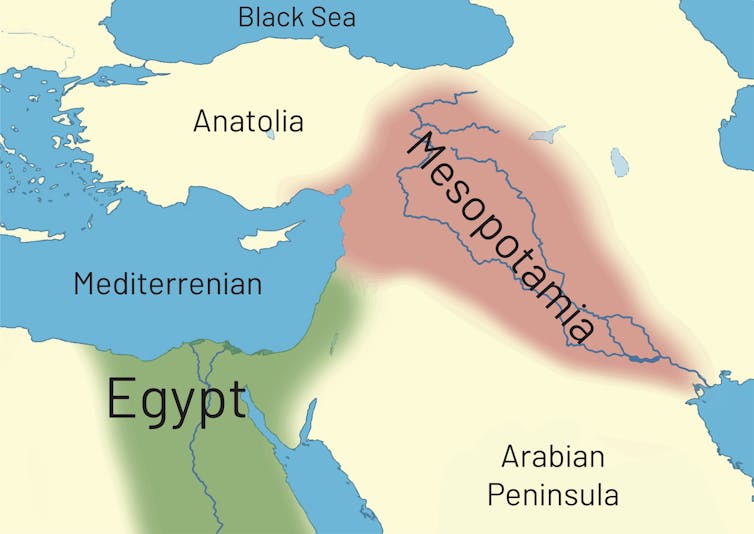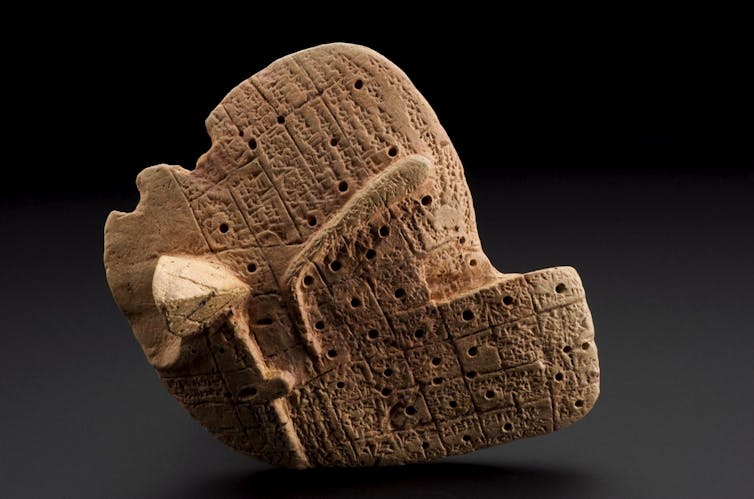
By Selena Wisnom
I’m standing in a basement kitchen prodding at a sheep’s liver, looking for marks on its smooth surface. People crowd around to film the proceedings, since I’m here to ask a question that everyone wants to know the answer to: will Donald Trump win the US election?
I’m following instructions that were first written down by the ancient Babylonians 4,000 years ago, and still survive today. Every crease on the liver has a meaning, and cuneiform tablets discovered in modern-day Iraq explain how to interpret them.
Armed with this knowledge, it’s possible to calculate the answer to any question, so long as it is yes or no, by adding up the number of positive or negative signs and seeing which comes out on top.
Since this liver had an overwhelming number of bad omens in it, I concluded that it declared no for Trump this time. Though in 2016 this method predicted a win well before he had won the Republican nomination, and in 2020 foretold that he would not be reelected that year.
What started as an entertaining talk for a university open day has since become a serious part of my research – not because I sincerely believe in it, but because it gives us some of the earliest evidence in history for how human beings reason and think.
Looking at livers also makes a serious underlying point about how humans have coped with uncertainty throughout history, and still struggle to today. People have developed techniques as varied as astrology, tarot cards and even peering into entrails in response to the agony of not knowing, or the strain of trying to make a difficult decision.
Given the level of feeling invested in this election, it’s a unique moment where perhaps we can appreciate that, in this respect, we are not so different from those who lived thousands of years ago, even if our methods of looking into the future are different.
Asking the entrails
Developed in its classic form in Babylon, entrail divination was practised throughout ancient Mesopotamia, the written history of which spans from the 3rd millennium BC to the 1st century AD.
It was enormously important in all sections of society – a standard part of political decision-making at the royal court, but accessible to all. Budget options were even available for those who could not afford a sheep.
People addressed their questions directly to the gods and believed that at the moment of asking, the answer would be written on the entrails. This could then be “read” by a diviner trained in this esoteric language.

aipsidtr / Shutterstock
Sitting in the British Museum is an archive of real questions that were asked by the king of Assyria (a kingdom in northern Mesopotamia) in the 7th century BC. All kinds of affairs of state were put before the gods. Are the Egyptians going to attack? Has the enemy taken the town under siege? And will the governors return home safely?
Reading the archive, you get a real sense of nerves on a knife-edge as the king waited for news from far away, wanting to know what had happened to his troops and trying to decide what to do next.
Not only did he ask them about what would happen in the future, but he also consulted them on possible courses of action. Should the Assyrian army go to war? Should the king send a messenger to make peace? Asking the opinion of the gods would have helped him feel more confident in his next steps.
The Babylonians did not have elections. But that did not mean the king could do whatever he wanted. It was important for his public image to have the gods onside, as well as for his own reassurance.
Whenever a powerful official was appointed, the entrails would be read to ensure the gods approved. The head of the army, high priests and other important positions were all subject to this requirement. On one occasion, even the choice of crown prince – and hence the future king of Assyria – was put to this test.
Interpreting the entrails was held to almost scientific standards of exactitude. Diviners worked in pairs or groups of up to 11, checking each other’s work to make sure they got it right. This was not a vague or woolly process, but a real attempt to ensure “accuracy” that could not be manipulated to simply come up with the answer that the king wanted to hear.
Modern forecasting
We all want to know what the future has in store, and have come up with ingenious ways of trying to find out, from opinion polls and data modelling to Paul the octopus, who developed a reputation for picking the winners of football matches during the 2010 World Cup. But are our methods really any better than looking inside a sheep?
As all investors are warned, past performance does not guarantee future results. Yet the only data we have to inform our predictions comes from the past, and most of our models can’t take into account “unknown unknowns”.
As many experts have found, predicting the future is a difficult business: opinion polls can lie and people change their minds, while economists have often been blindsided by a sudden crash.

Science Museum Group Collection, CC BY-NC-ND
Since liver divination only answers “yes” or “no”, it is going to be right 50% of the time just through the law of averages. Despite its randomness, its success rate may well have seemed convincing at the time.
And when we trust the authority of the source, it’s easy to find a way to explain away a wrong result – the prediction got halfway there, answered a different question, or would have been right if x hadn’t happened.
We shouldn’t be blind to the weaknesses of our own methods. We are often wrong, and the Babylonians could sometimes be right.
![]()
Selena Wisnom is lecturer in the Heritage of the Middle East at the University of Leicester in Britain.





























Sebelius Gotfried VI says
Interesting narrative to illustrate the extreme dependency electorates have on numbers as a way of grasping political significance. But it’s only one sign of how confounded Americans are by current political circumstances. Though many thinkers have presented a version of How We Got Here, which indicate in rather limited ways how that happened, America’s electorate seems to still wonder, Huh? They’re not screaming, “I’m mad as hell and I’m not going to take it anymore.” Instead, reminiscent of Thoreau’s quiet desperation, they are whispering, “Is this nightmare really happening.” Of course it is, but Why?
A brief survey of a handful of writers may well clear up some of the mystery and reveal a few of the prevailing forces at work. First, a kind of surgeon general’s warning: If you are exclusively blaming the former President for all, or even most of our afflictions, please move on. True, the former President has been and still is, for the sake of nonpartisan simplicity, an unsettling character, he was, despite the appearance of being truly unique, made in America and thus bears — in dramatic fashion — the inadequacies of its culture. And moreover in many ways he represents the grave challenges that America will have to face after, it now appears, his defeat. When and if that happens, the next meaningful assignments for advancing beyond this catastrophic set of conditions will challenge a society that seems woefully unprepared to respond favorably. And, frankly, it’s not completely the fault of the right or the left, though each has been responsible in varying degrees for the morass we are in. Rather, it’s been the chain of historical circumstances influencing the course of destiny, including philosophical, sociological, anthropological, and psychological components.
Wait a minute! Who’s got time for all that stuff? As the story above points out, Stick to the polls, the numbers, the so-called debates and pop rallies. Sorry, for the next few minutes I’m hoping you are willing to dig deeper for that is where the causes lie. This is where the concepts that need to be explored are found. Let’s start at the beginning with Friedrich Nietzsche’s (1844-1900) “Genealogy of Morals,” a strikingly brash review of human development. Nietzsche, who was famous for declaring, “God is dead,” for being an unabashed misogynist, and an inspiration for National Socialism, although unlike his friend Wagner was not anti-Semitic, was intensive;y critical of Christian morality, Germans, and Germany in general, explored ancient Greece and prehistoric consciousness. Like many Nineteenth century Europeans he was disenchanted with the course of cultural development, proclaiming in”The Will to Power” that nihilism would be the history of the next two centuries. As an aside, the former President is an adept nihilist, and, arguably, may serve as an indisputable proof of Nietzsche’s prediction.
In the “Genealogy of Morals,” he notes, “Let me declare expressly that in the days when mankind was not ashamed of its cruelty, life on earth was more cheerful than it is now that pessimists exist.” His point: Morality, Restrictiveness, Religiosity, Sin, Shame, are downers; the unfettered instincts — Might Makes Right — were carefree and guiltless. Oddly, paradoxically, this notion profoundly resonates with the Right, which claims to be essentially Christian, while at the same time cherishing a free-wheeling, Libertarian sense of freedom, which often resonates with a Might Makes Right sensibility. And in that light the left winger who bemoans birds drowning in oil spills, frogs being eradicated by pesticides, indigents who are hungry, Blacks who suffer the indignities of racism, non-binary individuals in the midst of rebuke are the pessimists who are ruining the party. In the right-wing freewheeling mindset, Why talk about Native Americans suffering inequities, women who are being treated unfairly, the environment that’s being ruined, and — God forbid — reparations? They’re simply asking, Can’t we just move on? Can’t we carry military-style weaponry without condemnation? After all, they’re wondering, What’s Freedom all about? C’mon people give up the impossible ideals; you’re dreaming. Nonetheless, the left won’t budge. The consequence: stalemate.
The left doesn’t understand how they’re perceived as sticks in the mud, the party-poopers, the dreadfully Woke people because by comparison the extreme right pursues extravagantly religious, culturally conservative positions such as pro-life, prayer in school, Christian decorum, and Sunday school. But neither side accurately accounts for the contradictions that naturally occur in human nature, or more precisely, within human consciousness. For Daniel Dennett, consciousness consists of multiple drafts — numerous interpretations of reality, perceptions, dreams, truth, falsity — existing simultaneously within our minds. On the outside, after numerous internal adjustments, individuals may appear certain, confident, consistently self-assured, while innately, a stream of conflicting, confusing sensations — feelings and thoughts — vie for approval. Several key psychological theories account for this perceptual whirlwind.
Leon Festinger and associates at Stanford studied a cult that was certain a flood would occur on Dec. 21, 1954. When it didn’t followers who weren’t as attached to those beliefs were willing to acknowledge they were wrong. But the true believers rationalized that it didn’t happen because of their belief that it would. Call it pretzel logic. Festinger concluded that the more intense the commitment to a belief is the less likely it will be relinquished despite the existence of abundant, contradictory evidence. Based on such studies Festinger presented the concept of cognitive dissonance. Subsequently, it has become a blanket explanation for true believers who hold contradictory beliefs. By itself, it doesn’t adequately explain the process.
Solomon Asch showed how the tendencies of individuals willing to conform to beliefs can be stronger than their values or basic perceptions. This is known as the Asch Paradigm. Walter Mischel explored how much behavior is related to environmental cues and how individuals yield to phenomenon like peer pressure. Albert Bandura developed social learning theory, demonstrating how children emulate aggressive patterns they are exposed to regardless of other factors. These psychologists and others emphasize how powerful external influences are on behavior and how readily individuals are to accept what would otherwise be innately unacceptable.
Another factor involved in juggling mutually contradictory beliefs is the issue of truth, which Hannah Arendt points out has routinely been subordinated, especially in the realm of politics, for other expedient aims. In writing about “The Pentagon Papers” she remarks, “how vulnerable is the whole texture of facts in which we spend our daily life; it is always in danger of being perforated by single lies or torn to shreds by the organized lying of groups, nations, or classes.” This is especially true regarding the practice of demonization, which relegates the opposition to a category of being evil, and according to the logic of zealotry entitles accusers to resort to any means possible, including lying, to eradicate that which is perceived as vile, wicked, threatening, and evil. The strain of self-righteousness that is so prevalent in today’s political perspectives invariably provides an assumed license to do whatever is necessary to defeat the evil opposition. This is not the result of genuine religious morality used to make judgments, but instead it’s mostly a manufactured, secularized, hyper-inflated form of condemnation aimed at political forces deemed to be the enemy. In the past such accusations were reserved for Nazis and actual Communists; now they’re indiscriminately cited for the sake of abject derision and character assassination.
According to Max Weber in “The Sociology of Religion” the presence of charisma is essential to religious leadership. To some the former President is deemed a savior who will protect hold lands and holy traditions. To his more secularized followers, however, he doesn’t posses the charisma of religiosity, especially of an ascetic nature. Quite the contrary. As an apostle for unfettered prosperity, he possesses a form of charisma based on celebrity fortified by a fable accentuating economic brilliance, shrewd judgment, global renown, and rare genius. And thanks to cognitive dissonance forgotten are the six times he declared bankruptcy and other fiscal transgressions. Over two millennia ago Greek philosophers devoted themselves to a core assignment: determining the difference between appearance and being. Most of the former President’s followers are unconcerned about such an exercise, preferring instead to embrace appearance and jettison actual being.
Lastly, two thinkers worth considering are Giambattista Vico (1664-1744) and ibn Khaldun (1332-1406). Vico proposed a theory that nations rise and fall in cycles: the age of gods, the age of heroes, and the age of humans, during which a sense of the divine is diminished, the masses seek luxuries, and thought becomes abstract. In this modern Gilded Age, in which the stock market and digital currencies have been setting records, Vico’s theory seems to have a degree of relevance. This is one of the reasons the right wing resonates with followers: the left shows little interest in aligning itself with or appealing to devout believers, following the tradition that religion is a personal concern not a public or political objective. But parents and teachers challenged by a diminishing sense of authority, attenuated common morality, and increasingly rambunctious children now expect political solutions to problems that used to be mainly solved by the culture. And the left hasn’t yet grasped the depth of that crisis.
Lastly, ibn Khaldun, a devout Muslim is probably history’s first sociologist, but certainly not a secular one. He emphasized the concept of asabiyah, which is the sense of community that holds people together beyond just familial and tribal ties. It’s not an idea based on economics and thus it’s not pre-Communistic; it refers to a tangible sense of social solidarity. He says, “governmental and educational laws destroy fortitude, because their restraining influence comes from outside. The religious laws, on the other hand, do not destroy fortitude, because their restraining influence is something inherent.” This seems remarkably similar to modern Libertarian ideology. But today, two components for that idealized view don’t exist in sufficient levels for that ideology to work effectively: 1. an exceedingly comparative-competitive environment that doesn’t encourage much solidarity, and 2. an advanced level of secularization based to a large extent on individualism and upward mobility. This scheme is also supported by the Social Darwinism professed by William G. Sumner (1840-1810), and Ayn Rand — two prominent templates for modern conservatism.
America has a rich history of creativity and resourcefulness and would be able to resolve many if not most of these issues and glaring contradictions, if it truly understood them. But that would require the kind of herculean effort Americans don’t seem willing to provide, based on how insubstantial this unnecessarily protracted and painful political stretch has been. If, however, America is actually the land of the brave and conducts itself collectively in such a spirit, it will realize it’s been lost in the woods for quite a spell and now it’s time to reach profound accommodation in order to rise to a new level of advancement. One can only hope.
Sherry says
Self absorbed pontification taken to the extreme.